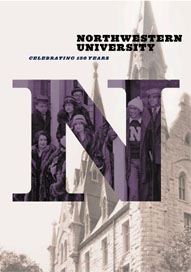 |

The Wartime Campus
The fall of France to the Nazis in June 1940 began a period
of intense wartime preparation for government, industry, and education
throughout the United States.
Like most universities, Northwestern was eager to make its contribution,
and within a few months students, faculty, and administration
had begun a program of all-out readiness. Even before the United
States entered the war, Dean of Faculties Frederick D. Fagg assumed
the role of campus coordinator for the federal Office of National
Defense Activities. He increased the size of the NROTC program,
facilitated a number of defense-related technical research projects,
and oversaw military-related academic work, such as efforts in
the psychology department to improve Army personnel selection.
(This echoed a ground-breaking Army personnel system devised by
psychologist Walter Dill for the government in World War I.)
Northwestern also volunteered its facilities and was chosen as
a site for a Naval Reserve Midshipmen's School, the V-7 program,
which filled Abbott Hall, the newly completed dormitory on the
Chicago campus. Between 1941 and 1945 V-7 turned out more than
24,000 ensigns. They were called "90-day wonders," and
one of them was the eventual skipper of PT-109, John F. Kennedy.
A major Navy program on the Evanston campus was V-12, the Navy
College Training Program, which placed uniformed trainees in class
for a year and a half of continuous study, after which came active
duty and officer's training. Many returned to Northwestern to
finish their degrees after the war.
The Navy Radio School was yet another major training program,
bringing apprentice seamen to the Evanston campus for 16 weeks
of class at the Technological Institute. After classes in theory,
code, and radio operations, some 6,000 graduates of this school
came out with the rank of seaman radioman or radioman third class.
In all, Northwestern was responsible for 11 separate military
programs for the duration of the war, including a Navy Flight
School, an Army Signal Corps program, and the revival of Base
Hospital #12, the Northwestern field hospital unit that had served
in France in World War I, which established itself in North Africa
and Italy during World War II.
p. 162
Select another excerpt.
Order the book now.
|
|